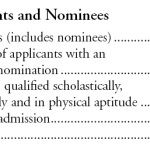January 30, 2012
Build a USNA Midshipman–Part III
Building a Midshipman is the story of one applicant’s journey from high school student to Midshipman in the United States Naval Academy.
It has been the bible for many military academy applicants, whether their goal is a spot at the Naval Academy, West Point, the United States Air Force Academy or the Coast Guard Academy. Now, Monday’s, I’ll serialize it on this blog for free. Of course, if that’s too slow, you can purchase the book on the publisher’s website or Amazon. Either way, you get lots of tips and tricks for cracking the Naval Academy application.
To be sure you don’t miss any of these:
Here’s the third installment:
Chapter One–Part One
Who You Are
I am an American. I serve in the forces which
guard my country and our way of life.
I am prepared to give my life in their defense.
I will never surrender of my own free will. If in command,
I will never surrender the members of my command
while they still have the means to resist.
— USNA Code of Conduct
Your name is Maggie Clara Schmidt, a freshman at the local public high school. You’re a muscular 5’6”, 135 pounds, with wavy auburn hair—permed once, but never dyed. You resisted the childhood fad of piercing ears or other body parts (lucky for you because the USNA now requires a waiver for all piercings and tattoos). Freckles pepper the bridge of your nose and high cheekbones declare your European ancestry. Dimples decorate your face every time you crack an unsolvable math problem, unravel the physics of an everyday event, or enjoy the humor of your friends. Clear eyes sparkle with a menacing intelligence that demands honesty and forthrightness from those who draw their focus. You value principles and hard work—which might make you an oddity on the high school campus if not for the similar group you’ve found. You can smell the rancid scent of disingenuouty, deceit, and posturing on those around you, like spoiled food.
For your entire life, you lived (past tense now that your official residence has become the Naval Academy) in a middle-class two-story California home with a younger brother, two Labrador retrievers (bed Labs of course), and two parents. Across the street stretches a park where your AYSO and Club soccer teams practiced dribbling, where you perfected martial arts kenpos for competitions, where you struggled with the flexed arm hang for the USNA Physical Aptitude Examination, and sometimes where you just sat amidst nature to study.
It took seven years before your parents bought living room furniture, the couch so old even the Salvation Army refused it. Instead, they spent the money on music lessons and sports—and then tutoring when the full force of high school hit. You redecorated your bedroom once in soft pinks and purples, but never again because you stopped noticing the walls and bed covers. The room shrunk to the Desk—a compact space with books, papers, pencils—the accoutrements of a student.
Your heritage is imbued with the scent and feel of the military. Your Uncle spent twenty years in the Navy—starting as NROTC at New Mexico State University. One grandpa served as a Navy seaman during WWI and the other survived three wars as a proud Marine. Several cousins tried military life, but, like coraframs (USNA dress shoes) that you can’t wait to kick off of tired feet, it didn’t fit. You spent thousands of hours preparing for your Shaolin kenpo black belt with a Master Sergeant in the Marines. Test day, his military rigor and toughness brought both of you through. His son—a fellow martial artist—followed him into the Marines and you attended his boot camp graduation at the San Diego Marine Corps Recruiting Depot.
Between sports, music and studies, your life resembles the tightly woven fabric of the Navy’s dress blues. Since elementary school, your days have been a balancing act of physical activities, concerts, martial arts (what your mom calls a ‘life skill’), church and academics—a pentagonal foundation for life. Somehow, busy-ness replaced the popularity contest other girls spent hours a day pursuing. You tried only once to be “fashionable”—in sixth grade—but couldn’t quiet your outspoken tongue. It became clear that perspicacity soothed your spirit like comfort food, even as it charted new waters.
You practiced karate four to six hours a week, violin ten hours a week, spent at least five hours in church activities, and ten to fifteen hours in soccer. Not to mention studying. And if you had free time, you gravitated toward family activities. Your dad has a sharp sense of humor, his quick wit defusing many tense situations. You learned that trait from him—the value of jest in social interactions.
Both of your parents pursued careers in addition to parenting, until your brother’s fourth grade. That providential year, your mom retired to manage his learning difficulties, as well as maintain various and sundry bumps and potholes along childhood’s path—until your dad “retired” four years later. Though you didn’t understand it at the time, that confluence of events—an at-home parent just as your cerebral characteristics emerged—changed your life.
Unexpectedly, long-term parental unemployment produced few changes in your life. In fact, you barely noticed it. You had already learned parsimonious lessons. No one in your family buys new clothes just to be in style, so you don’t feel denied. The important activities remain, like music lessons, academic tutoring, and sports which can be played on a custom size turf. You never went to school hungry (you still struggle to control your weight, especially as you bulk up with muscle), although now the family eats what’s on sale. Boxed breakfast cereal almost disappears from the menu. Hardier and healthier food starts the morning—yoghurt, homemade granola, fruit, oatmeal. Mom cooks many meals from scratch—breads, candies, baked spaghetti. That makes you a hit with your friends. Your Dad begins cooking, too, and what a cook he turns out to be! Bar-b-ques, crock pot meals, Julia Child casseroles. Over time, you find that you despise fast food.
Sometime during high school, well into the unemployed years, you begin wondering how the family has enough money for everything. Your mom explains that they purchased the house fifteen years ago out of foreclosure, and now live on the equity. They husband their funds: nothing wasteful, but nothing lacking. This becomes your first real lesson in budgets, as you come to understand the trade-off made on a daily basis in balancing a finite amount of money against infinite wants and needs. And you learn to accept the hand dealt you by fate and God.
Truly, you are too busy to shop the malls, redo your wardrobe, or participate in parties and movies that other teens take for granted. Even if you had the money. Your parents put the family income (and eventually savings) into keeping the children busy, knowing that experiencing success results in self-confidence. The breadth of activities that fill your days and weeks means one always excels, even as another founders. Sometimes you win a karate competition. Sometimes, you score a hat-trick. And other times, you get the A in math you worked against all odds to get. In the end, you feel self-assured and in control.
Family vacations end up the mandated travel accompanying childhood. You sweat through a week in Ontario California competing in the American Youth Soccer Organization International Tournament (you lost). The death of your Grandma takes you to Wisconsin for four days. You and your brother spend nine days in a summer orchestra camp playing Grieg and Shostakovich. In high school, you participate in the Naval Academy and USAFA Summer Seminars, followed by three weeks at the University of Notre Dame’s summer science workshop.
But most summers, you attend summer school, either at the high school or the local community college, retooling weak classes and working ahead in other subjects. As do most of your friends.
(Chapter One continued next week)
If you don’t want to wait through the installments (or can’t)–or want to access the workbook, Building a Midshipman can be purchased here:
- Amazon.com (print book)
- Scribd.com (digital edition)
- Structured Learning (Publisher’s website–either)
Jacqui Murray is the editor of a technology curriculum for K-fifth grade and author of two technology training books for middle school. She wrote Building a Midshipman, the story of her daughter’s journey from high school to United States Naval Academy midshipman. She is webmaster for five blogs, an Amazon Vine Voice book reviewer, a tech columnist for Examiner.com, Editorial Review Board member for ISTE’s Journal for Computing Teachers, IMS tech expert, and a weekly contributor to Write Anything. Currently, she’s editing a thriller for her agent that should be be out to publishers this summer. Contact Jacqui at her writing office or her tech lab, Ask a Tech Teacher.







